Happy Birthday, Margaret Burbidge! – Sky & Telescope
The astronomer who taught us we are all made of stardust celebrates her 100th birthday on August 12, 2019.
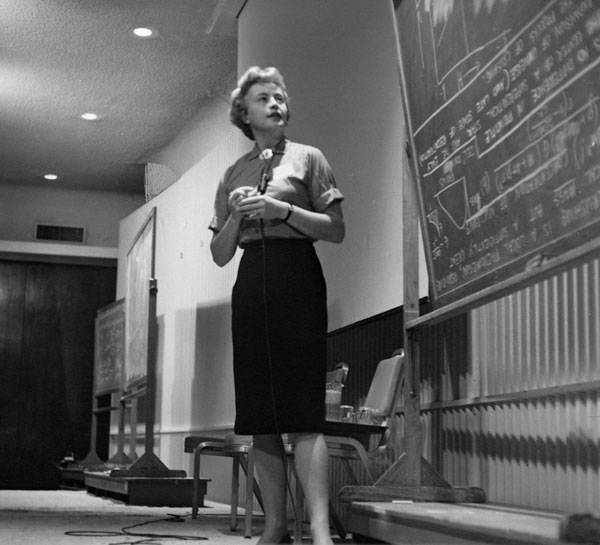
Margaret Burbidge, who celebrates her 100th birthday in August, had a long and stellar career in multiple fields of astrophysics. One of her most significant achievements was formulating our understanding of nucleosynthesis in stars. Among positions she held in her lifetime were director of the Royal Greenwich Observatory and president of the American Astronomical Society, both the first time that a woman filled the post. The photograph shows Burbidge in Dallas, Texas, in February 1964.
Sky & Telescope archive
“You can’t give telescope time for this junk science! Who does she think she is?” blustered a young upstart upon hearing that an elderly astronomer wanted half a night with one of the brand-new Keck telescopes to observe objects that might disprove the Big Bang theory.
Observatory Director Joe Miller was quick to put the youngster in his place: “You just look up Margaret Burbidge, the Margaret Burbidge, and you’ll know who she is,” he said. “If Margaret Burbidge wants half a night to draw up pictures of Mars, I’ll give it to her — whether we think it’s crazy or not, we’re going to show respect to one of the greatest astronomers of the 20th century.”
Though the night turned out to be cloudy and she wouldn’t have found evidence to support an alternative to the Big Bang anyway, this mid-1990s episode — when Burbidge was already in her 70s — is but one of many in a career spanning more than 60 years that highlight a determination to push the frontiers of human knowledge.
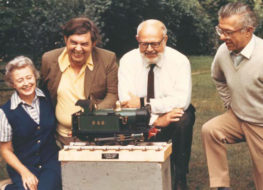
Margaret and Geoff teamed up with Willy Fowler (third from left) and Fred Hoyle (at right) to write one of the seminal papers in all of astrophysics. They not only worked together, they also played together — here they’re celebrating Fowler’s 60th birthday in July 1971, admiring his model train engine.
Master and Fellows of St John’s College / Cambridge / Donald Clayton
Born Eleanor Margaret Peachey in Davenport, UK, to chemist parents, Burbidge caught the astronomy bug early. “She became interested in the stars when she was three or four years old,” explains her daughter, Sarah Burbidge. “Her family took a night ferry crossing to France for a holiday, and for the first time the stars were clearly visible to her, and she was smitten.”
This fascination, combined with a talent for mathematics, developed to the point where she was reading the books of astronomer and mathematician Sir James Jeans, a distant relative on her mother’s side, by the age of 12. She went on to study astronomy at University College London, graduating in the summer of 1939 with little ceremony due to the looming cloud of war.
Over the next few years, the fresh graduate split her time between maintaining the University of London Observatory at Mill Hill in the absence of the many scientists and technicians sucked into the war effort, fabricating optical instruments for the armed forces, and graduate studies.
For her PhD thesis, she analyzed spectra of the variable star Gamma Cassiopeiae. She observed in the harshest of conditions, often alone at night in a cramped space under a cold open dome, sometimes with the fear-inducing sounds of flying bombs going off around her. Yet she never complained, offering the first hint of the steely determination and thirst for knowledge that would later define her: “Those nights, standing or sitting on a ladder in the dome of the Wilson reflector . . . fulfilled my early dreams,” Burbidge later recalled in a 1994 memoir.
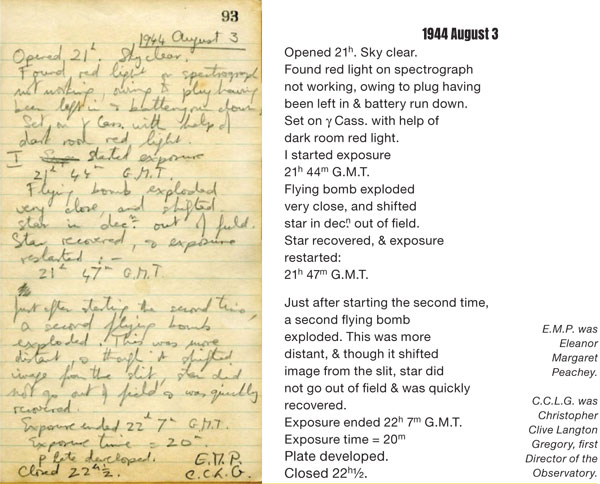
Burbidge conducted her PhD research during the World War II years. Between wartime duties, she observed Gamma Cassiopeiae at the University of London Observatory in Mill Hill Park. The telescope was donated by J. G. Wilson, and it’s not to be confused with the Mount Wilson Observatory in California. While observing on the night of August 3rd, Burbidge was twice interrupted by bombs exploding nearby, but neither incident rattled her, as is clear from her notes.
University College London Observatory
The years immediately following World War II would turn out to be career-defining for the young astronomer. Alongside giving classes on practical astronomy on the observatory roof — to students that included an enthusiastic undergraduate named Arthur C. Clarke — she also attended graduate lectures in physics. There, she immediately hit it off with “an interesting person” called Geoffrey (Geoff) Burbidge who she would go on to marry just six months later.
From the outside, the pair made an unlikely couple. Geoff was a large man with a truculent, impatient character, while Margaret was so demure and quiet that Miller claims, “My wife always used to say ‘If Queen Elizabeth ever needed a stand-in, Margaret could do it’.”
But appearances can be deceiving. Though Geoff had strong scientific views and a penchant for a heated argument, he was honest, loyal, and carried on friendships with colleagues with whom he disagreed, and even promoted them. And as for Margaret, “It was the classic iron fist under her velvet glove,” says Miller. “She knew what she knew and believed strongly, and she would stick to her principles.”
Fruitful Collaboration
In fact, it was Margaret’s passion for and knowledge of astronomy and spectroscopy — the analysis of starlight by wavelength — that prompted Geoff to switch from physics soon after they married, spawning a winning collaboration that led to numerous new insights into chemically peculiar stars. In one study, they performed the first detailed spectral analysis of Alpha2 Canum Venaticorum, now considered the prototype of a class of variable stars that harbor strong magnetic fields. Among numerous seminal results in the paper, published in 1955, they also showed that the star had, on average, an overabundance of rare earth metals of about 800 times that of the Sun. This finding piqued the interest of distinguished experimental nuclear physicist William (Willy) Fowler. At the time, Fowler was spending a year in Cambridge, UK, working with Fred Hoyle. In 1946 and 1954, Hoyle published the first-ever papers in which he theorized how stars might forge hydrogen and helium into the heavier elements found throughout the universe, a concept now known as stellar nucleosynthesis. This went against the established notion that the elements were all derived from the Big Bang.
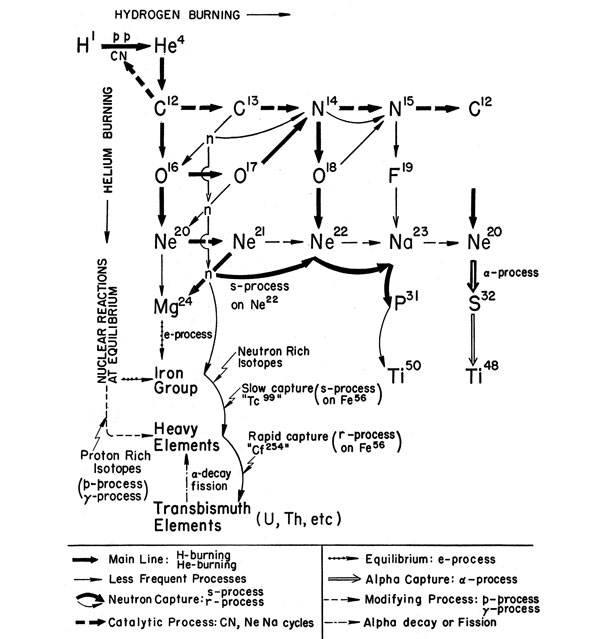
The seminal “B2FH” paper on stellar nucleosynthesis, headed by Margaret Burbidge, was cited so often that the authors were referred to as “B2FH.” Above is a schematic diagram of the nuclear processes by which the synthesis of elements in stars takes place. This tour de force is 108 pages long.
E. M. Burbidge et al. / Reviews of Modern Physics Vol. 29, No. 4, P. 547 (1957) / American Physical Society
Seeing how the Burbidges’ research and expertise could help in proving Hoyle’s stellar nucleosynthesis idea, Fowler invited Geoff and a pregnant Margaret to join them in Cambridge. They immediately clicked: “You can’t imagine how much fun they all had working together,” says Sarah Burbidge. The next year and a half was a flurry of intense activity.
Though Margaret was so far along in her pregnancy that “Willy said he was worried she would ‘pop’,” says Sarah, it didn’t deter her from making key observations that helped identify all the processes within stars that form the elements populating the periodic table (except for the very lightest). This included expanding on Hoyle’s earlier work to show how elements up to iron could be created by the successive stages of nuclear fusion as a star evolves. They also illuminated how fast and slow neutron capture, the r- and s-processes, could explain the observed abundances of elements heavier than iron.
The result of all these efforts was a 108-page paper written by Margaret and Geoff along with Fowler and Hoyle, and published in Reviews of Modern Physics in October 1957. It showed how elements are formed at various stages of the stellar life cycle, and perhaps most importantly how most of the elements that make up everything around us — and ourselves — originate from stars. “This one paper just completely laid the foundation for what is going on in terms of the formation of the chemical elements,” summarizes Miller.
“Synthesis of the Elements in Stars,” as it was titled, quickly popularized the idea of stellar nucleosynthesis in the scientific community. The article was referenced so often that it was later simply referred to as B2FH (after the first letter of each author’s surname) for short. It became and remains a landmark contribution to nuclear astrophysics.
Yet the paper was not without controversy. Hoyle and Geoff were key proponents of the Steady State theory of the universe. Unlike the Big Bang theory, in which the observable universe had a definite beginning, the Steady State concept maintained that the universe has and always will exist. Importantly, it claimed that the universe could generate new matter, which B2FH demonstrated. However, this victory for the Steady State community would soon be drowned by a tsunami of evidence in favor of the Big Bang picture, in particular the discovery of a faint glow coming from all directions. It soon became clear that this glow was relic radiation left over from the early universe that today we know as the cosmic microwave background.
From a historical perspective, that Hoyle and Geoff remained stubborn adherents to Steady State cosmology — long after the consensus deemed it had been disproved — somewhat overshadowed the light they both illuminated on numerous scientific mysteries throughout their careers. The memory of Burbidge’s contributions to astronomy, in contrast, remains unfettered by the controversy.
Cleverly, she rarely offered her opinion publicly on theoretical matters, either leaving Geoff to slug it out or, if he were absent, astutely contributing to the debate by starting her argument with: “If Geoff were here, he would say . . . ” Sarah feels the reason for this was simple: She was never a theoretician. “I don’t think Mum ever worried about where Fred’s theories might lead,” she says. “Remember that she was an observational astronomer, focused on her observations and reducing spectra.”
A New Astronomical Mystery
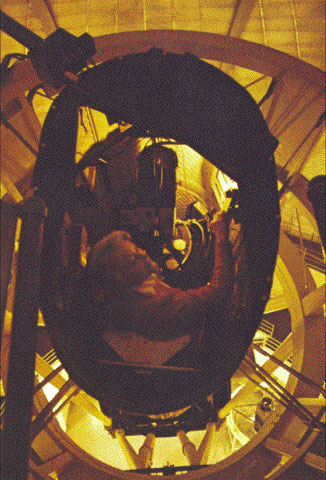
An overhead photo taken around 1970 shows Burbidge sitting in the “cage” of the Shane 3-meter (120-inch) telescope at Lick Observatory owned and operated by the University of California. Nowadays, observers operate telescopes from comfortably heated control rooms, sometimes miles away from the actual dome.
Sarah Burbidge
Having wielded these formidable observational skills in B2FH, Burbidge needed a new scientific mystery to get her teeth into. After 10 years working with Geoff measuring the rotation of stars and gas in disk galaxies and studying peculiar galaxies and galaxy clusters, she eventually found it in the newly discovered puzzling objects we now call quasars — or, as they were termed at the time, quasi-stellar objects.
The first positively identified quasar to be observed and identified as such, 3C 273, caused a tremendous commotion in the astronomical community in 1963. Barring any new physics, it was shining 40 times more brightly than the brightest known galaxies. Plus it had a redshift — meaning its light is shifted toward the red end of the spectrum because of its motion away from the viewer — that placed it far beyond our own galaxy, around 2.5 billion light-years away.
With only a few telescopes around the world that could obtain spectra of quasars, Burbidge was ideally placed to join the race to find more quasars with even bigger redshifts, given her access to the Shane 3-meter (120-inch) telescope at Lick Observatory. This she did — with a reputation as “a rather formidable driver,” she would quite literally speed to the observatory in their Jaguar. She discovered tens of examples, including OQ 172 at redshift 3.53 in 1973, a quasar that remained the farthest known for nearly a decade.
Though fascinating, quasars presented a problem for Hoyle, Geoff, and their dwindling band of fellow Steady State universe supporters. Unless some new physics peculiar to quasars could be mustered or observations of blueshifted quasars made, these redshifts were cosmological, indicating that the universe is expanding everywhere and that this expansion had to come from the Big Bang. As it became clear that neither of these would be forthcoming, Burbidge’s quasar observations turned out to be yet another nail in the coffin of the Steady State universe. However, Burbidge herself never saw it that way, keeping “an open mind always.”
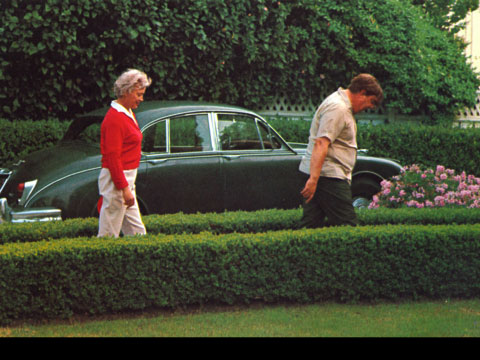
Margaret still owns the 1961 Jaguar Mark II, shown here behind the Burbidges. Although she doesn’t drive it anymore, she loves being driven around by Sarah and her grandson, Connor.
Sarah Burbidge
The latter years of Burbidge’s scientific career were spent probing the spectra of galaxies, determining galaxies’ rotations, masses, and chemical composition, and, of course, investigating quasars. She also played a major role in moving observational spectroscopy into the heavens, helping to develop the Faint Object Spectrograph (FOS) aboard the Hubble Space Telescope. The FOS was one of the original Hubble instruments, designed to detect the physical state and chemical composition of very faint objects such as quasars. Her last major scientific contribution was leading the FOS data analysis team. Among other findings, this team provided evidence for the presence of a massive black hole at the center of nearby elliptical galaxy M87 (see page 10 for more on M87).
As Hubble’s FOS was churning out new astronomical insights in 1995, Fowler died. Hoyle followed in 2001, with Geoff sadly passing away in 2010 at the age of 84. As a result, for almost a decade Margaret has remained the sole living member of B2FH. On the eve of her 100th birthday, it’s a good time to reflect on and applaud what she and the other members of B2FH achieved, as well as all the triumphs she can rightly claim are hers alone.
“You’ve made me look back over her 100 years — starting with observations from that little telescope in Mill Hill in the 1940s all the way to the development of the Faint Object Spectrograph on the Hubble Space Telescope — and it is really quite remarkable,” reflects Sarah. “She simply wanted to be very good at her work as an observational astronomer, and I would say she was probably the best of her generation.”
Triumph Over Obstacles
In her largely quiet and undemonstrative way, Burbidge’s handling of the many moments of discrimination she encountered during her career inspired other female astronomers to pursue and achieve their own ambitions.
1945
With World War II ending, Burbidge saw an opportunity to gain “access to larger telescopes, better instruments and clearer skies” in the U.S. through an advertisement for a Carnegie Fellowship at Mount Wilson Observatory. However, her hopes were immediately dashed when her application was denied — simply on account of her gender. “A guiding operational principle in my life was activated,” she said in her 1994 memoir. “If frustrated in one’s endeavors by a stone wall . . . one must find a way around.” Ten years later, Geoff submitted another application, which was accepted. The couple stayed in a separate summer cottage on the mountain away from the exclusively male dormitory, and Margaret was officially only there as Geoff’s assistant. In reality, Geoff conducted the dark room work and smoked cigars, while Margaret finally got to observe the heavens from Mount Wilson.
1971
The Annie Jump Cannon Award was the American Astronomical Society’s (AAS) oldest prize and the only one exclusively for women. It had been awarded to luminaries such as Cecilia Payne-Gaposchkin and Helen Sawyer Hogg, so it wasn’t at all surprising when the AAS wanted to award Burbidge with the accolade. What was surprising, instead, was the rejection letter Burbidge wrote in response. In it, she said “it is high time that discrimination in favor of, as well as against, women in professional life be removed, and a prize restricted to women is in this category.” Her refusal led to the creation of the first working group on the status of women in astronomy, and increased awareness of discrimination against women and other minority groups in astronomy.
1972
Just a year later, Burbidge became the first female astronomer to become a member of the National Academy of Sciences, and the first female director of the Royal Greenwich Observatory — but wasn’t elected Astronomer Royal, the first and only time in the organization’s history this occurred. Instead, Martin Ryle was given the position. Whether this was pure gender discrimination or a symptom of political shenanigans in the British astronomical community remains unclear. What was clear was that Burbidge didn’t want to be involved in the turmoil within British astronomy at the time, and she tendered her resignation just a year and a half later.
1976
Despite, or perhaps because of, the Annie Jump Cannon Award rejection, Burbidge was elected the first woman president of the AAS. At the time, the U.S. Equal Rights Amendment — guaranteeing the same rights for all American citizens regardless of gender — had been ratified by all but four states of the 38 required. (A 35th state, Indiana, ratified in January the following year.) Burbidge put forward to the membership the idea of banning annual AAS meetings from being held in the three dissenting states. She received highly polarized responses, but it narrowly passed, offering a signal of support from the AAS for women in science.
1983
B2FH was a transformative paper deserving of the highest accolades. And in 1983 this was recognized when Fowler was awarded the Nobel Prize in Physics. Yet even Fowler was shocked by the omission of his colleagues. Hoyle could have been left out for various reasons: his stance on the Big Bang theory, the various outlandish ideas he put forward in later life, or for heavy criticism of the committee in 1974 for awarding Antony Hewish and failing to recognize Jocelyn Bell Burnell’s contributions in discovering the first pulsar. Various commentators have since posited that Bell Burnell’s and Burbidge’s Nobel omissions were but two of many examples of sexism in astronomy. Burbidge remains characteristically reserved on the subject.
This article first appeared in the July 2019 issue of Sky & Telescope.






